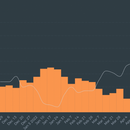Hi,
I’m located in Ottawa, Ontario and our home was built in 1968 and is a 1800sq/ft split level, 2×4 framed, 5.8 ACH/50 structure with an unfinished/uninsulated basement.
We are faced with an out of warranty natural gas furnace heat-exchanger replacement due to spalling corrosion (~2K CAD) before winter OR accelerating our plans to switch to a heat-pump without getting a chance to do the envelope upgrades I want first.
I’m struggling to decide, but my gut leans to fixing the furnace while I take 1-3 years to upgrade the envelope and then redo the energy audit (Hot2000) and use this as inputs for designing a heat-pump conversion to de-risk oversizing the equipment or getting a series of large bills for resistive heat.
To that end:
I’m trying to work out total BTUs produced by our 2006 natural gas force air furnace but our house also has (for the moment) a natural gas hot water tank.
I can think of three approaches:
#1)
Look at gas consumption over non-heating months (June-Aug) and assume this is average is constant over the year. Then subtract that from annual consumption to arrive at furnace consumption * furnace efficiency = BTU generated.
#2)
I have 18 months of EcoBee run-time data (pic attached from beestat.io) and since it’s a single stage furnace I could extract the furnace run-time data to arrive at an approximate BTU generated (based on specs from furnace when new). I’d probably have to account from the time when the heating call is made to when the burner turns on (power vent & air handler cycles up for ~15 seconds before the burner).
#3)
I have per second electric use data on all circuits including a dedicated one for the power vented hot water tank (Giant Inc PV50) using an Emporia Vue Gen 2. Use this estimate the duration that the gas burner was on.
My intuition tells me that a hot-water tank is probably programmed to turn on the power vent just prior to combustion and for a period of time afterwards. When the tank’s power-vent is on it draws 146.3W. I can’t see the flame on this unit so estimating the pre-post vent run-time is a bit of a guess, I asked Giant but no reply yet.
With this data, I can calculate burner run time X the BTU output consumption per hour / efficiency of the burner, and subtract this from the total gas consumption at the meter to arrive at an estimate of the furnace consumption. Not ideal, not very granular given the meter is monthly but it might work when viewed over the scale of a year
Once I get furnace BTU generation data I’d then have to apply that to heating degree days, etc… I plan to engage an HVAC engineer to help at that stage… my software eng skills only go so far 😛
Does anyone have any experience in this? Other ideas or suggestions?
Or am I over-thinking the risk of doing the heat-pump conversion ahead of; adding exterior continuous insulation, windows/doors, improved attic air/sealing and insulation, basement insulation.
I had hoped to do tackle some of these this summer but we are expecting a 2nd kiddo any day now, so….. priorities shifted… next summer though I have a 4 month paternity leave planned…. we’ll see how much I can take on.
Thank you











Replies
You want this!
https://www.greenbuildingadvisor.com/article/replacing-a-furnace-or-boiler
Should take only a few minutes. Heat loss is linear, so no need to overthink this. DHW will use more BTUs for the same gallons during the winter as the incoming water is colder, but will probably be insignificant.
Thanks Paul,
I had read that article maybe a year ago but I must not have used the right keyword searches to find it today when I looked for a similar question being asked before posting mine. I'll undertake Dana's proposed method and see what I get.
Great point about the incoming cold water temp increasing winter consumption. I have a waste water heat recovery device (pic attached) on the stack for our main shower feeding the shower and then the cold water inlet. It's incredible the difference it makes.
In the article you sent by Dana he writes:
"If the same heating fuel is also used for domestic hot water, this calculation method exaggerates the implied load numbers, since some of that fuel was used by the water heater and sent down the drain. But some of the space heating came via solar gains that would reduce the implied load numbers. These errors tend to balance each other out to a greater or lesser degree."
If we were to switch the hot water to another energy source the house would still have the same solar gains which would reduce the space heating energy needs. Perhaps he is saying that the solar heating gains are near equivalent (at certain latitudes/homes) to the energy consumed by a hot water tank on the same fuel meter as the furnace?
Amazing, I think the waste heat recovery pipes are incredible. I'm glad it's going so well.
Roughly how many therms (or whatever units) of gas did your house use last year? Dana's point is that this method is an estimation which is more accurate and quicker than other options while simultaneously not having to be perfect. Furnaces and heat pumps don't come in infinite sizes, so getting close is good enough.
I would do all three methods and see how closely they agree.
Total meter based consumption for the past 12 months is 2900 m3 of natural gas, and if I am converting it right that works out to 102.37 MMBTU.
Summer hot water tank consumption appears to be ~90 m3 / month. Keeping in mind that they only read the meter every 2 months I take the seasonal values with a bit of a grain of salt. If we stick with gas this winter I plan to do weekly meter readings manually and ideally ditch the gas hot water tank before winter.
So a rough estimate from the bills alone for the furnace is 1820 m3 or 64.25 MMBTU.
Attached are some screenshots from the gas company showing consumption & Degree Heating Days.
Wow! That's pretty low for heating but the domestic hot water is more than I expected, perhaps that's the kid factor. That fuel usage implies a low heat loss. One question: Is the 1800 sqft all above grade? Or split 900 above/900 below? Regardless, replacing with a heat pump will be easy.
You mentioned "adding exterior continuous insulation, windows/doors, improved attic air/sealing and insulation, basement insulation." I'd rethink this if the home is comfortable enough now. This bit of work will probably be unnecessary since you can fit a heat pump and your energy savings won't be significant. Air sealing, attic and basement insulation probably make the most sense of this list. Windows and doors make the least sense if you're content with the comfort of the existing ones.
Sorry I should have been more specific the unfinished below grade basement of 900 sq ft is not included in the 1800 sq ft I provided earlier.
I've attached screenshots of our 2020 EnerGuide report (PDF), specifically the 2nd page, lower right hand side as square footage (internal as measured for the model) and specifics on the current mechanicals. Including the model's heat suggested "design load heating" of 19.89KW of 68260 BTU/HR.
You can see in the PDF that this home as measured and modelled in Hot2000 consumes a fair bit. We have a 2 year old in the house which means lots of baths for which the waste water heat recovery device doesn't contribute much.
Thermal comfort in the bedrooms is especially poor, the exterior walls are very cold. I've had to run an electric radiant heater in my young daughter's bedroom overnight (on a thermostat). I'm presently adding mastic to all the duct work in the basement in an effort to improve flows into the bedrooms. There is a fair bit of interior stratification within the house, surprisingly it's cold upstairs in the winter compared to the main floor.
The exterior sheathing is an early generation of exterior drywall and neighbours report finding it moldy when residing. The foundation has exterior challenges (no damp-proofing, nearly clogged clay weeping tiles, etc..), I plan to fix those and insulate from the outside. The aluminum siding is also original with faded paint and damaged spots. The IGUs in the 1993 PVC insert windows have all failed with condensation visible between the panes. I may just swap the IGUs and keep the frames in the retrofit as they function well and don't appear to be the source of much leakage.
But yes, I'm probably going a bit overboard. My goal is to put a 13KW solar system up on the roof and be as close to net-zero as possible.
Anyways I've deviated a lot from the original question, I'm going to follow Dana's approach, and then use the EcoBee data as DC_Contrarian suggested as a sanity check. If these two are way off I may pursue an estimate of the hot water tank consumption based on the time periods that the power vent was on.
Thank you both
You can toss that energy audit: they predicted you’d use 4000 cubic meters and you used 2900/year while running baths? Their heat loss isn’t even close to reality unfortunately.